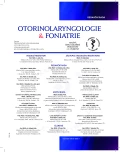The Brno Implant Centre: An Analysis of Cochlear Implant Complications in Adult Patients
Authors:
B. Gál 1; R. Kostřica 1; J. Hložek 1; T. Talach 1; M. Veselý 1; D. Slouka 2; D. Hošnová 1; J. Rottenberg 1
Authors‘ workplace:
Klinika otorinolaryngologie a chirurgie hlavy a krku, Lékařská fakulta Masarykovy univerzity a Fakultní nemocnice u sv. Anny v Brně
1; Otorinolaryngologická klinika, Lékařská fakulta Univerzity Karlovy v Plzni, Fakultní nemocnice Plzeň
2
Published in:
Otorinolaryngol Foniatr, 68, 2019, No. 1, pp. 24-29.
Category:
Original Article
Overview
Objective: A retrospective analysis of complications in a group of patients who underwent unilateral cochlear implantation at the Department of Otorhinolaryngology and Head and Neck Surgery, Saint Anne’s University Hospital in Brno between 6/2012 and 4/2018.
Methods: A study group: 77 patients, 33 men (43%) and 44 women (57%), mean age 47 years (18-87 years). Type of cochlear implantation (CI): unilateral CI in 74 patients (2 of which electro-acoustic hybrid implant was used); 3 bilateral sequential CI; the total number of CI was 80. The brand of implant: Med-El in 75 cases (97%) and Cochlear in 2(3%) patients.
Results: 30 complications were observed in 23 patients (29.9%) from which 5 patients (6.5%) experienced serious complications. 24 complications (80%) were mild while 6 complications were serious (20%). Mild complications: 3 cases of subcutaneous wound hematoma (3.8%), superficial wound infection handled conservatively in 3 patients (3.8%), 8 short-term vertigo problems (10%), 3 reversible facial nerve palsies (3.8%), 1 pathological stimulation of the facial nerve (1.3%), 3 cases of tinnitus (3.8%) and 3 cases of taste disorders (3.8%). Serious complications: long-term problems with vertigo in 3 patients (3.8%), 1 electrode displacement (1.3%), 2 cases of infections leading to the implant extrusion (2.5%), no irreversible facial nerve palsy (0%), and no failure of an implant (0%). Timeline breakdown of complications: 6/2012-12/2014 : 32 implantations, 17 complications in 21.3% patients from which 4 patients (5.0%) had serious complications. 1/2015-2/2018 13 (16.3%) complications in 48 cases of implantation from which 2 complications were serious (2.5%).
Conclusion: Cochlear implantation is a standard and safe method of hearing rehabilitation in patients with severe hearing impairment. The percentage of surgical complications negatively correlates with the length of the experience with cochlear implantation, i.e. learning curve. The vast majority are complications of mild, transient nature and are successfully solved by conservative measures. Serious complications are rare, and their frequency is less than 3% in recent years.
Keywords:
hearing loss – deafness – cochlear implantation – complication of cochlear implantation
Sources
1. Antonelli, P. J., Lee, J. C., Burne, R. A.: Bacterial biofilms may contribute to persistent cochlear implant infection. Oto. Neurotik., 25, 2004, 6, s. 953-957.
2. Bouček J., Kluh J., Čada Z. et al.: 30 let kochleárních implantací v České republice. Čas. Lék. čes, 156, 2017, s. 178-182.
3. Collins, M. M.: Cochlear implantation in a district general hospital problems and complications in the first five years. J. Laryngol. Otol., 111, 1997, s. 325-332.
4. Coordes, A., Basta, D., Gotze, R. et al.: Sound-induced vertigo after cochlear implantation. Otol. Neurotik., 33, 2012, 3, s. 335-342.
5. Cunningham, C. D., Slattery, W. H., Luxford, W. M.: Postoperative infection in cochlear implant patients. Otolaryngol. Hed Neck Surg., 131, 2004, s. 109-114.
6. Dalmia, D., Behera, S. K.: Signifcance of round window niche drilling for cochlear implant surgery. Indian J. Otol., 23, 2017, s. 141-145.
7. Hansen, S., Anthonsen K., Stangerup, S. E. et al.: Unexpected findings and surgical complications in 505 consecutive cochlear implantations: A proposal for reporting consensus. Acta Otolaryngol., 130, 2010, 5, s. 540–549.
8. Im, G. J., An, Y. S., Choi, J. et al.: Analysis of bacterial biofilms on a cochlear implant following Methicillin-resistant Staphylococcus Aureus infection. J. Audio. Otol., 18, 2015, 3, s. 172-177
9. Jiam, N. T., Limb, C. J.: The impact of round window vs cochleostomy surgical approaches on interscalar excursions in the cochlea: Preliminary results from a flat-panel computed tomography study. World J. Otorhinolaryngol. Head Neck Surg., 24, 2016, 2(3), s. 142-147.
10. Karimi, D., Mittman, P., Ernst, A. et al.: Surgical treatment of vertigo in cochlear implantees by electrode resealing. Acta Otolaryngol., 137, 2017, 10, s. 1031-1034.
11. Kusuma, S., Liou, S., Haynes, D. S.: Disequilibrium after cochlear implantation caused by a perilymph fistula. Laryngoscope, 115, 2015, 1, s. 25-26.
12. Saito, T., Shibamori, Y., Manabe, Y. et al.: Incidence of regeneration of the chorda tympani nerve after middle ear surgery. Ann. Otol. Rhinol. Laryngol., 111, 2002, 4, s. 357-363.
13. Su, W. Y., Marion, M. S., Hinolosa, P. et al.: Anatomical measurements of the cochlear aqueduct, round window membrane, round window niche and facial recess. Laryngoscope, 92, 1982, s. 483-486.
14. Venail, F., Sicard, M., Piron J. P. et al.: Reliability and complications of 500 consecutive cochlear implantations. Arch. Otolaryngol. Head Neck Surg., 134, 2008, 12, s. 1276-1281.
15. Wang, J. T., Wang, A. Y., Psarros, C. et al.: Rates of revision and device failure in cochlear implant surgery: a 30-year experience. Laryngoscope, 124, 2014, 10, s. 2393-2399.
16. Yasumatsu, K., Kusuhara, Y., Shigemura, N. et al.: Recovery of two independent sweet taste systems during regeneration of the mouse chorda tympani nerve after nerve crush. Eur. J. Neurosci., 26, 2007, s. 1521-1529.
Labels
Audiology Paediatric ENT ENT (Otorhinolaryngology)Article was published in
Otorhinolaryngology and Phoniatrics

2019 Issue 1
Most read in this issue
- Congenital Stridor
- Asymmetric Hearing Loss
- Cholesteatoma Behind an Intact Tympanic Membrane – Retrospective Study
- Tumor Microenvironment
